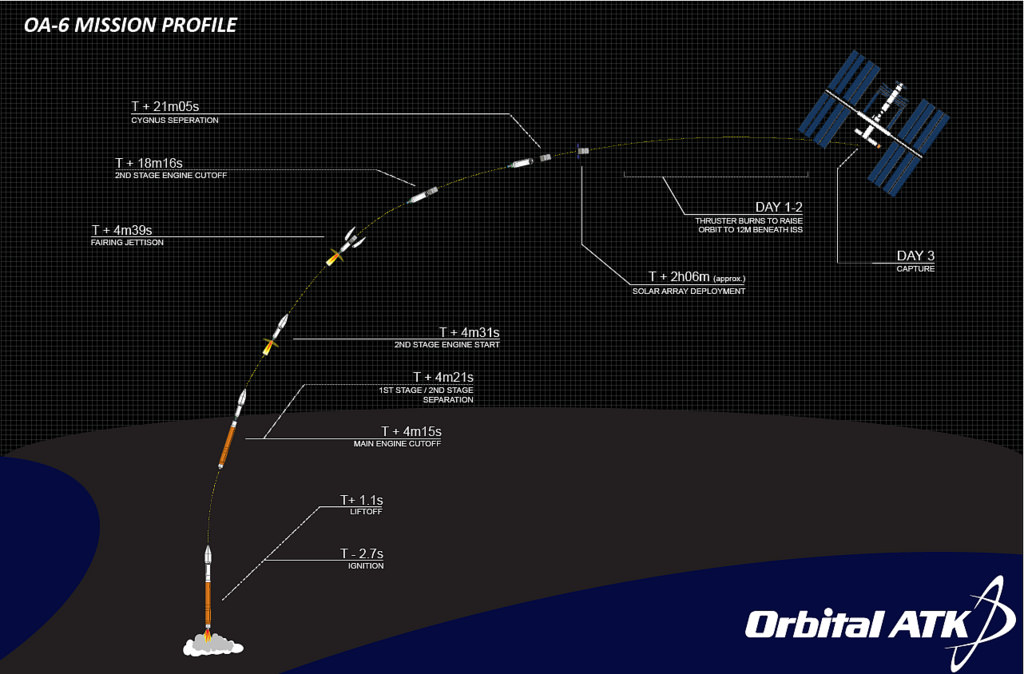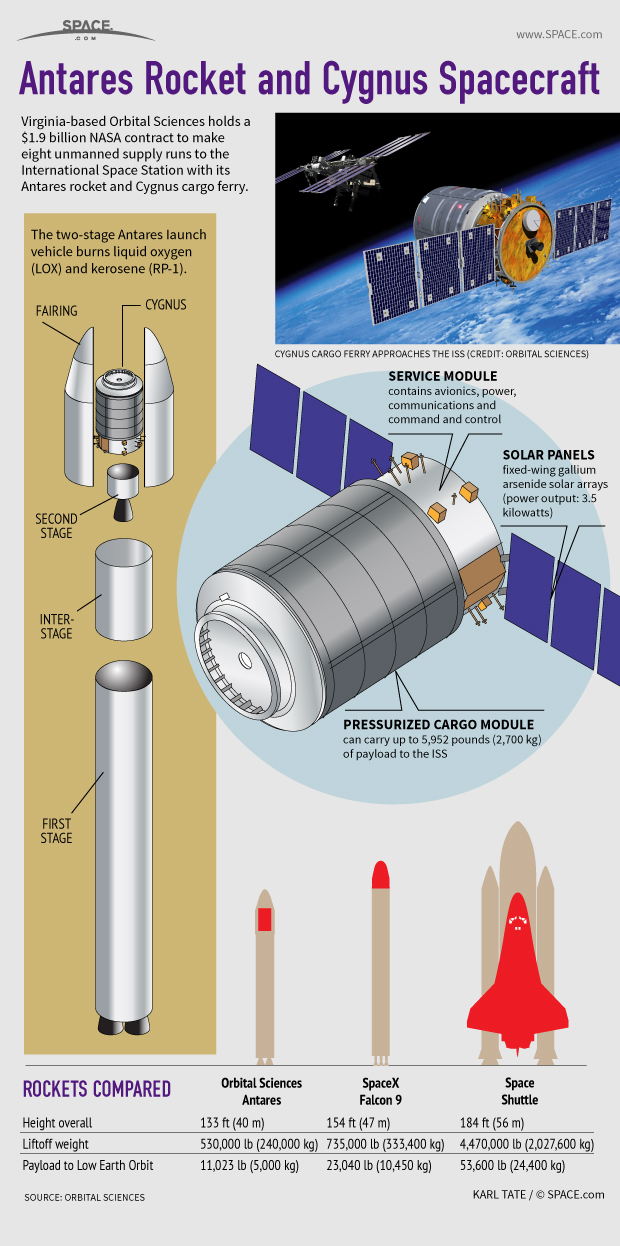Space Station Cargo Launch Tonight May Be Visible Along East Coast

People in eastern North America have a chance to see a private cargo spacecraft launch toward the International Space Station tonight (March 22).
Orbital ATK's robotic Cygnus spacecraft is scheduled to launch atop a United Launch Alliance Atlas V rocket from Cape Canaveral Air Force Station in Florida tonight at 11:05 p.m. EDT (0305 GMT on Wednesday, March 23). You can watch the liftoff live here at Space.com, courtesy of NASA TV.
The launch will take Cygnus on a path nearly parallel to the U.S. East Coast, and the glow created by the Atlas V's engines should therefore be visible in varying degrees along much of the Eastern Seaboard, weather permitting. [Cygnus Carrying Lots of Science to Space Station (Video)]
The two-stage Atlas V's first stage is powered by an RD-180 engine, which will burn for 4 minutes and 15 seconds. Six seconds after the RD-180 shuts down, the rocket's first and second stages will separate. Then, 10 seconds later, the Atlas V's Centaur upper stage will fire up and burn for 13 minutes and 38 seconds. Two minutes and 49 seconds after the Centaur shuts down, the Cygnus freighter will separate and head into orbit.
The first stage should create a fairly conspicuous light in the night sky, while the Centaur upper stage will likely be considerably dimmer.
Air Force weather forecasters say there is an 80 percent chance of favorable launch conditions Tuesday night, with cumulus clouds posing the only concern. If unsettled weather or a technical problem scuttle Tuesday's attempt, backup opportunities are available Wednesday at 10:40 p.m. EDT (0240 GMT on Thursday, March 24) and Thursday at 10:17 p.m. EDT (0217 GMT on Friday, March 25).
What to expect
The Atlas V booster should be readily visible to many viewers in the southeastern United States, thanks to the fiery output of the first stage's powerful RD-180 engine. The light emitted will be visible for the first 4 minutes and 15 seconds of the launch out to a radius of about 500 miles (840 kilometers) from Cape Canaveral, an area more than three times the size of Texas.
Breaking space news, the latest updates on rocket launches, skywatching events and more!
Depending on where you are relative to Cape Canaveral, the Atlas V might become visible at any point from just a few seconds after launch to perhaps 4 minutes after liftoff.
The upper-stage Centaur will be visible only by virtue of the light emanating from its single RL10C engine. How will this look? This description of the previous Cygnus-Atlas V launch, in December 2015, by Astronomical Society of Long Island member Tom Peninno provides a guide:
"It was about 6 minutes into the flight that I went outside and viewed to the very clear southern sky, hopefully to get a glimpse of the Centaur engine, along with Cygnus, riding up and out along the East Coast. It took about 2 minutes, then all of a sudden, a bright light appeared in the SSE sky. I would estimate its magnitude to be about 0, and [it] appeared approx 25 degrees in altitude, moving smoothly and quite rapidly towards the east. The pass was observed for at least 2 minutes, eventually fading from view along the eastern horizon. I must tell you that it was a magnificent sight, one of the best and clearest viewings of rocket launches that I have ever observed." [The World's Tallest Rockets: How They Stack Up]
You may want to scan the sky with binoculars to get the best view of the Centaur firing.
Where to look
For most viewers, depending upon your distance from the coastline, the rocket will be relatively low on the horizon (5 to 25 degrees — your fist on an outstretched arm covers about 10 degrees of sky). So be sure there are no buildings or trees to obstruct your view. The exceptions are along the immediate Atlantic coast of Nova Scotia, where the Atlas V will be seen to climb rather high into the southeast sky, and the Avalon Peninsula of southeast Newfoundland, where the rocket will pass almost directly overhead.
Also keep in mind that the rocket likely will appear to move very fast, much faster than an orbiting satellite due to its near-orbital velocity at low altitudes. The rocket will basically travel across 90 degrees of azimuth in less than a minute.
Here's a brief viewing guide for different portions of the Eastern Seaboard:
- Southeast U.S. coastline: Anywhere north of Cape Canaveral, viewers should initially concentrate on the south-southwest horizon. If you are south of the cape, look low toward the north-northeast. If you're west of the cape, look low toward the east-northeast.
- Mid-Atlantic region: Look toward the south about 3 to 6 minutes after launch.
- Northeast: Concentrate your gaze low toward the south-southeast about 6 to 8 minutes after launch.
- Nova Scotia and Newfoundland: Concentrate low toward the south-southwest about 8 to 10 minutes after launch.
Canadian fireballs?
Last December, a Canadian astrophotographer based in Nova Scotia caught sight of a pair of brilliant fireballs "traveling sort of parallel to each other," which were visible in the sky for only about 10 seconds before they vanished out of sight. The sighting was made about 15 minutes after the Atlas V and Cygnus launched from Cape Canaveral.
Some speculate that these fireballs might have been re-entering components of the Atlas V rocket. If so, perhaps viewers based in Maine or Canada's Maritime Provinces will see a repeat performance about 12 to 16 minutes after Tuesday's launch.
Editor's note: If you capture an amazing photo of Tuesday's rocket launch or any other night-sky sight that you'd like to share for a possible story or image gallery, send images and comments to Managing Editor Tariq Malik at spacephotos@space.com.
Joe Rao serves as an instructor and guest lecturer at New York's Hayden Planetarium. He writes about astronomy for Natural History magazine, the Farmer's Almanac and other publications, and he is also an on-camera meteorologist for News 12 Westchester, N.Y. Follow us @Spacedotcom, Facebook or Google+. Originally published on Space.com.

Joe Rao is Space.com's skywatching columnist, as well as a veteran meteorologist and eclipse chaser who also serves as an instructor and guest lecturer at New York's Hayden Planetarium. He writes about astronomy for Natural History magazine, Sky & Telescope and other publications. Joe is an 8-time Emmy-nominated meteorologist who served the Putnam Valley region of New York for over 21 years. You can find him on Twitter and YouTube tracking lunar and solar eclipses, meteor showers and more. To find out Joe's latest project, visit him on Twitter.


